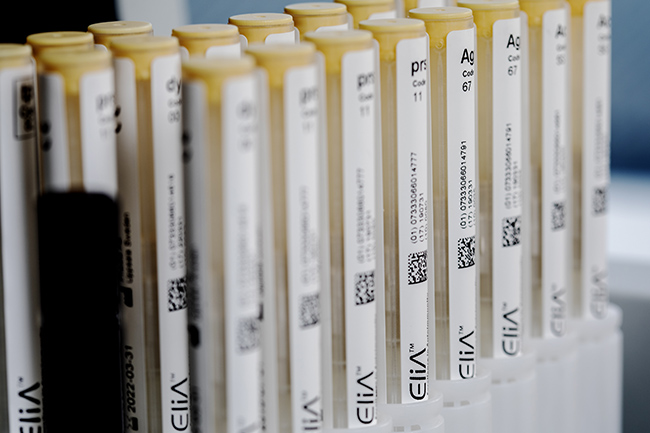食物過敏的 ImmunoCAP™ 特異性 IgE 檢測
使用可靠的診斷工具最佳化食物過敏病患的管理。
可以改變人生的食物過敏原檢測結果。
有興趣將 ImmunoCAP 加入檢測組合中的實驗室人員,請探索 ImmunoCAP 產品目錄。

ImmunoCAP 食物過敏原檢測的特別之處為何?
多年的研究且受科學社群信賴
ImmunoCAP 檢測廣見於超過 6,000 篇科學文獻1 和無數的健康指南,是體外過敏診斷的黃金標準2,累積超過 50 年的研究和開發成果。
為何將 ImmunoCAP 檢測用於食物過敏病患?
適合多樣化食物過敏的多種檢測選項
從最常見到最少見的食物過敏原,ImmunoCAP 檢測提供眾多檢測選項。請聯繫產品專員,深入瞭解我們的食物過敏原檢測選項。
ImmunoCAP 檢測能為食物過敏病患提供什麼幫助?
食物過敏檢測可能有助於管理其他疾病狀態。
濕疹
80% 患有嚴重異位性皮膚炎的嬰兒有食物過敏的問題,例如牛奶、蛋白和芝麻。5 ImmunoCAP 特異性 IgE 檢測可協助提供深入見解,探明這些症狀是否源自食物過敏、非過敏誘發因素或其他原因。
氣喘
氣喘病患如果同時患有食物過敏,其面臨嚴重發作的風險會增加,6 而檢測可幫助您讓病患避開某些誘發因素並建構氣喘管理計畫。
非過敏性食物相關疾病
ImmunoCAP 特異性 IgE 檢測可協助診斷過敏疾病。7 這對區別過敏和非過敏病症 (例如腸躁症 (IBS)) 而言特別有幫助。4
ImmunoCAP 檢測訂購流程如何運作?
非常簡單,只要 1... 2...3...
讓實驗室進行分析
實驗室將在 Phadia 實驗室系統上處理 ImmunoCAP 檢測。
收取檢測結果
評估和解讀 ImmunoCAP 檢測結果,將病患管理個人化。

如何解讀食物過敏原成分檢測結果?
讓我們協助您解讀
無論您是初級照護提供者或專科醫師,過敏原成分檢測結果解讀指南會提供明確指引,說明對不同種類食物過敏原成分的致敏化會如何影響病患管理計畫。
特異性 IgE 血液檢測結果應與病患的臨床病史和身體檢查一起解讀。8-10 ImmunoCAP 血液檢測結果將指出病患是否對特定過敏原敏感 (即具有 IgE 抗體)。然而,對特定過敏原的致敏化並不代表患有臨床過敏,因為敏感不一定會導致症狀發生。8,11
探索 ImmunoCAP 檢測提供的項目。
如需有關 ImmunoCAP 檢測、過敏及/或教育工具和資源的其他資訊,請聯絡我們的過敏專家。
相關資源
協助您診斷和病患管理的工具。
1. Data on file
2. Crameri R. The crux with a reliable in vitro and in vivo diagnosis of allergy. Allergy. 2013 Jun;68(6):693-4. doi: 10.1111/all.12177. Epub 2013 Apr 27. PMID: 23621640.
3. Canonica, G.W., et al., A WAO - ARIA - GA(2)LEN consensus document on molecular-based allergy diagnostics. World Allergy Organ J, 2013. 6(1)
4. Onyimba F et al. Food Allergies and Intolerances: A Clinical Approach to the Diagnosis and Management of Adverse Reactions to Food. Clinical Gastroenterology and Hepatology. 2021: 1-11
5. Martin PE, Eckert JK, Koplin JJ, Lowe AJ, Gurrin LC, Dharmage SC, Vuillermin P, Tang ML, Ponsonby AL, Matheson M, Hill DJ, Allen KJ; HealthNuts Study Investigators. Which infants with eczema are at risk of food allergy? Results from a population-based cohort. Clin Exp Allergy. 2015 Jan;45(1):255-64. doi: 10.1111/cea.12406. PMID: 25210971.
6. Wang J, Liu AH. Food allergies and asthma. Curr Opin Allergy Clin Immunol. 2011;11(3):249-254.
7. See Directions for Use: Phadia™ ImmunoCAP™ Specific IgE 0-100; Phadia 250 Laboratory System. Published 2019-10-24.
8. Eigenmann P A, Atanaskovic-Markovic M et al. Testing children for allergies: why, how, who and when: an updated statement of the European Academy of Allergy and Clinical Immunology (EAACI) Section on Pediatrics and the EAACI-Clemens von Pirquet Foundation. Pediatr Allergy Immunol 2013;24(2):195-209
9. Bousquet J, Anto J M et al. Allergic rhinitis. Nat Rev Dis Primers 2020;6(1):95.
10. Scadding G K, Scadding G W. Diagnosing allergic rhinitis. Immunol Allergy Clin North Am 2016;36(2):249-260
11. Popescu F D, Vieru M. Precision medicine allergy immunoassay methods for assessing immunoglobulin E sensitization to aeroallergen molecules. World J Methodol 2018;8(3):17-36





